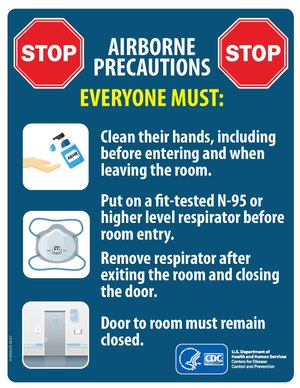Airborne transmission
Airborne transmission
File:Safe Spaces - how to reduce virus transmission indoors - 9hP41EaypD4.webm
Airborne transmission refers to the spread of infectious agents caused by the dissemination of aerosols that remain infectious when suspended in air over long distances and time. This mode of transmission is significant in the spread of various infectious diseases, including tuberculosis, measles, and COVID-19.
Mechanism of transmission
Airborne transmission occurs when infectious agents are carried by dust or droplet nuclei suspended in the air. These droplet nuclei are small particles, typically less than 5 micrometers in diameter, that can remain airborne for extended periods and travel long distances. When inhaled, these particles can deposit in the respiratory tract, leading to infection.
Aerosol generation
Aerosols can be generated by various activities, including coughing, sneezing, talking, and certain medical procedures. The size and concentration of aerosols can vary depending on the activity and environmental conditions.
Environmental factors
Several environmental factors influence airborne transmission, including:
- Ventilation: Adequate ventilation can dilute and remove infectious aerosols from indoor environments.
- Humidity: Low humidity can increase the suspension time of aerosols in the air.
- Temperature: Temperature can affect the stability and viability of infectious agents in aerosols.
Diseases transmitted by airborne route
Several diseases are known to be transmitted via the airborne route, including:
- Tuberculosis
- Measles
- Varicella (chickenpox)
- COVID-19
Prevention and control
Preventing airborne transmission involves a combination of strategies:
Airborne precautions
Airborne precautions are specific infection control measures used to prevent the spread of diseases transmitted by the airborne route. These include:
- Use of N95 respirators or higher-level personal protective equipment (PPE) by healthcare workers.
- Isolation of patients in rooms with negative pressure ventilation.
- Limiting the movement of patients outside their rooms.
Environmental controls
Improving ventilation and air filtration in indoor spaces can reduce the concentration of infectious aerosols. The use of HEPA filters and ultraviolet germicidal irradiation (UVGI) are effective methods to inactivate airborne pathogens.
Related pages
Transform your life with W8MD's budget GLP-1 injections from $125.
W8MD offers a medical weight loss program to lose weight in Philadelphia. Our physician-supervised medical weight loss provides:
- Most insurances accepted or discounted self-pay rates. We will obtain insurance prior authorizations if needed.
- Generic GLP1 weight loss injections from $125 for the starting dose.
- Also offer prescription weight loss medications including Phentermine, Qsymia, Diethylpropion, Contrave etc.
NYC weight loss doctor appointments
Start your NYC weight loss journey today at our NYC medical weight loss and Philadelphia medical weight loss clinics.
- Call 718-946-5500 to lose weight in NYC or for medical weight loss in Philadelphia 215-676-2334.
- Tags:NYC medical weight loss, Philadelphia lose weight Zepbound NYC, Budget GLP1 weight loss injections, Wegovy Philadelphia, Wegovy NYC, Philadelphia medical weight loss, Brookly weight loss and Wegovy NYC
|
WikiMD's Wellness Encyclopedia |
| Let Food Be Thy Medicine Medicine Thy Food - Hippocrates |
Medical Disclaimer: WikiMD is not a substitute for professional medical advice. The information on WikiMD is provided as an information resource only, may be incorrect, outdated or misleading, and is not to be used or relied on for any diagnostic or treatment purposes. Please consult your health care provider before making any healthcare decisions or for guidance about a specific medical condition. WikiMD expressly disclaims responsibility, and shall have no liability, for any damages, loss, injury, or liability whatsoever suffered as a result of your reliance on the information contained in this site. By visiting this site you agree to the foregoing terms and conditions, which may from time to time be changed or supplemented by WikiMD. If you do not agree to the foregoing terms and conditions, you should not enter or use this site. See full disclaimer.
Credits:Most images are courtesy of Wikimedia commons, and templates, categories Wikipedia, licensed under CC BY SA or similar.
Contributors: Prab R. Tumpati, MD


